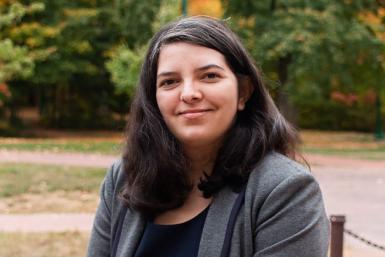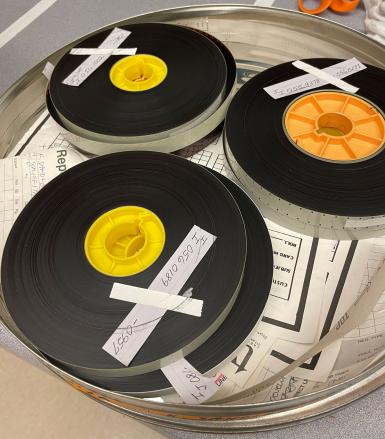BFC/A re-houses Kathe Sandler Collection film elements
Kathe Sandler’s 1993 documentary, “A Question of Color,” shines a light on color, race and colorism, issues Sandler herself dealt with growing up as a light-skinned African-American in an interracial family. The film’s production took eight years to complete.

Now, thanks to The Media School’s Black Film Center/Archive, the film will be preserved for generations beyond Sandler to experience and research.
The BFC/A is home to a collection of 16mm film and sound outtakes, original negatives, other film pre-production elements, interviews and transcripts from “A Question of Color” and “Remembering Thelma,” which Sandler donated in 2010. When the film preservation organization IndieCollect was working on a restoration of “A Question of Color,” it contacted the BFC/A in search of a missing element.
Archivist Amber Bertin discovered that the film and all its materials were in their original cans and boxes and not in archival containers. The labels were crumbling, meaning the information was at risk of being lost. She determined the BFC/A needed to re-house all the materials for conservation purposes.
“You’re responsible for making sure those materials last, because if those materials disappear, nobody has access to them,” Bertin said.
Associate professor Terri Francis, director of the BFC/A, said she teaches “A Question of Color” every fall semester.
“The film is about Black people’s experiences with white supremacy as it is expressed in ideas about beauty, desirability and identity,” she said. “In particular it’s how white supremacy alienates people from their own bodies. Sadly it’s never dated. Many students relate and many have their eyes opened.”
Along with the quarter-inch film the movie was taped on, Sandler also donated video transcripts, historical material and interviews of various prominent figures, such as Johnny Ford, former mayor of Tuskegee, Alabama, and writer and director Rhonda Baraka.

“There is a lot of wealth in the outtakes, or there could be, and somebody may discover that at some point,” Sandler said.
Seeing that the original collection was haphazardly housed in a giant stack of cardboard boxes and metallic cans, archival assistant Dan Hassoun began to organize the materials.
“My task was to open each and every one of these hundreds of boxes and cans and see what treasures and mysteries and strange delights ended up being inside each one,” Hassoun said.
Hassoun made sure to be careful with each new box he encountered. Sometimes, he found two or more rolls of film stacked on top of each other, which led to the tape that had been holding them together to degrade the film itself and unspool and tangle with one another.
“Sometimes there was original paper material, like handwritten notes or camera sheets that were housed in the reels inside the cans, which presents a preservation issue because as paper degrades, that affects the actual celluloid film,” Hassoun said.
After correcting film storage mistakes, he started to separate the contents into different cans and different folders. In an average can or box, there would be two reels, a magnetic audio track and a positive video track.
“I would take out all of the paper records, label them accordingly, designate a barcode and a name and then place them into a manila folder,” Hassoun said.
Then, he took the individual reels and separated each of them into Tuscan cans, plastic film cans that are PH-neutral and made of polyethylene, which eliminate the chance of interacting with other film materials. These cans have tiny slits in them, which allow the film to outgas acetic gas (which smells heavily of vinegar) and escape the container. This process is especially good for acetate film, which is what “A Question of Color” was filmed on.

This prevents acetate decomposition or “vinegar syndrome.” If films that have vinegar syndrome are stored next to films that don’t have vinegar syndrome, the healthy films will pick up the condition, speeding up their decomposition. Thankfully, none of the materials from “A Question of Color” had vinegar syndrome.
Organizing an archived film and its materials means tracking where the materials came from and knowing the history of custody in order to determine originality. This process ties in with the French term, “respect des fonds,” which essentially means original order and organizing the materials based upon the way the donor had the materials arranged.
“It’s believed there is inherent research value based upon how the donor arranged the materials in addition to just the subject matter and what the content materials are,” Bertin said.
In addition to checking on the physical condition of the film and its materials, Hassoun also tracked everything he found in the boxes and recorded the information on a spreadsheet.
“The result of (Dan’s work) is that we have so much more information about this collection than we did before,” Bertin said. “Now we have a spreadsheet and information that we can look at, without pulling the films, that tells me what the film is, what condition it’s in, and how large it is, which gives me enough information to make higher-level decisions about how we want to manage these materials and what kind of future preservation efforts we want to do on them. That is a huge benefit.”

Hassoun spent 10 days completing this logistically challenging yet rewarding project.
“Working with physical film is always rewarding for me,” Hassoun said. “Specifically to the particular period that we are living in and having spent most of last year and this year doing my work involving film materials online and remotely, it actually was refreshing and rewarding to be reminded that these are physical objects and being able to handle them and visualize them is something you can’t necessarily do remotely.”
The BFC/A is celebrating its 40th anniversary this year. For Bertin, Francis and Hassoun, film archiving sheds a light on valuable films that are worth maintaining.
“I feel like that takes on additional importance within a Black film center, because Black films by and about Black people have been among the most disregarded in film history,” Hassoun said. “Giving them a space and a platform takes on additional importance.”
Currently, the BFC/A is open by appointment only. To schedule an appointment, email Amber Bertin at abertin@iu.edu or the general BFC/A email, bfca@indiana.edu. You can also view some of the BFC/A collections online in digital format at https://bfca.sitehost.iu.edu/collections/.

